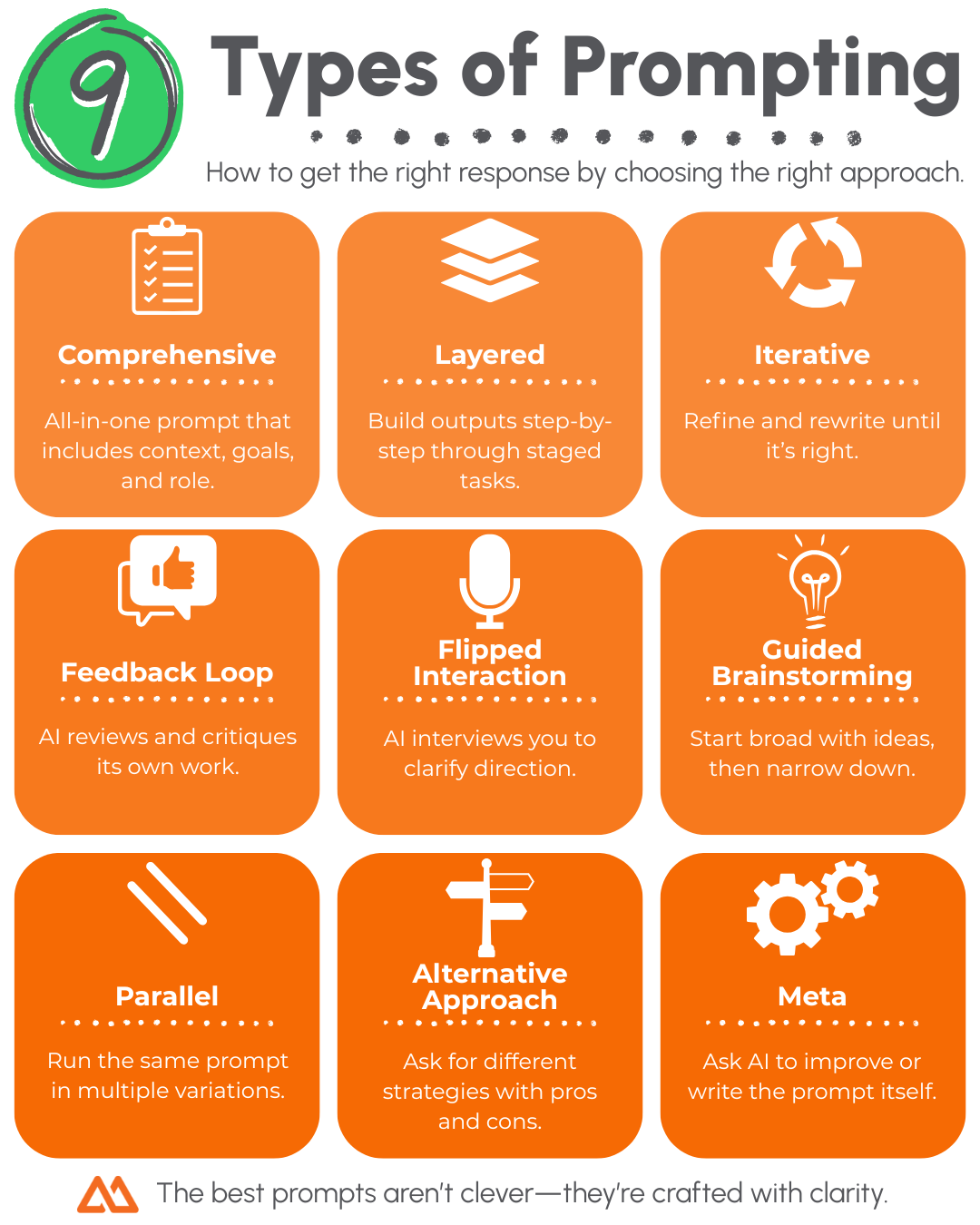Listen To This Blog Post
Are there better ways to prompt AI?
Despite what many say, creating an effective prompt doesn't always require the standard inputs, such as role, background, goal, and guidelines. While these things are almost always necessary, they don't always have to be delivered in the same familiar boilerplate:
Dad Joke Writer:
You are a seasoned dad-joke writer who treats puns like fine wine.
Context: You’re preparing material for your big night at the PTA talent show, where the theme is “innovation.”
Goal: Write three original dad jokes that sound painfully clever but oddly sincere.
Constraints: Keep them under two sentences each. Avoid recycled wordplay.
Task: Deliver all three as if you’re testing them out loud, complete with awkward pauses or groans.
Evaluation: Each joke should make readers sigh before they smile.
In reality, there are many different ways to prompt AI, just as there are various types of brushes used by artists. The key is to know which brush to use when, to recognize how the variations in the patterns and structures of your prompts can change the quality of what you get back, and to iterate on those results.
Because most people only use one or two prompt styles—or worse, no formal technique at all—AI can seem overrated, underwhelming, and even something to avoid. By mastering the following prompting techniques, though, you can learn to work with AI in new ways to help you make the most of your human inputs.
1. What is comprehensive prompting?
This is the classic “give it everything” approach. You front-load all the details at once as we did in the example above—role, goal, tone, audience, context, output type—and expect a full response.
It’s ideal when you already know what you want and just need it executed cleanly. Think: full blog drafts, campaign outlines, or long-form assets.
It’s fast, but rigid. AI doesn’t have much room to think with you; it just performs the brief.
EXAMPLE:
See above.
2. What is layered prompting?
This method breaks big work into smaller, sequential steps. You might first ask AI to analyze a dataset, then outline a structure, then write from that outline.
Layered prompting works well for creative or complex workflows where clarity compounds over time, each layer sharpening the next.
EXAMPLE:
Step 1: “List the key challenges foodservice operators face when adopting AI.”
Step 2: “Outline a blog structure around those challenges.”
Step 3: “Write the full post.”
3. What is iterative prompting?
Iteration is about refinement. You generate a draft, critique it, and then ask AI to try again—over and over—until it feels right. The goal is a polished outcome, not speed or efficiency.
Writers use it to refine tone. Designers use it to improve phrasing. Strategists use it to stress-test logic. Regardless of who uses it, iterative prompting is the closest AI comes to an editing partner.
EXAMPLE:
“Revise this paragraph to sound more human and less corporate, keeping the same message.”
4. What is feedback loop prompting?
Here, you flip the script and ask the AI to review its own work. Ask it to evaluate its output on the initial goals of the prompt.
This is especially useful for audits, brainstorms, or testing whether the AI followed its own instructions. You’ll often get insights you wouldn’t have thought to check yourself.
EXAMPLES:
“Evaluate this for clarity and bias.”
“Give me three ways this could be improved.”
"Provide a percentage of accuracy based on the original prompt based on these five core components."
5. What is flipped interaction prompting?
This might be my favorite prompting style because it's so interactive. Instead of you asking the questions, ask the AI to interview you. Put your earbuds in, and take a walk!
Flipped interaction is all about surfacing what you don't know yet using an authentic, conversational method. This is 100 percent the best prompting method for leveraging multi-modal voice.
EXAMPLE:
“You are a venture capitalist considering an investment in my company. Please review my business plan and ask me the top 20 questions that could make or break your decision.”

6. What is guided brainstorming prompting?
It's just what it sounds like. You start wide and narrow down. First, you ask AI to generate a bunch of ideas without judgment. Then, you filter, combine, or evolve the best ones.
It’s ideal for early-stage creative work, such as naming projects, exploring story angles, or building campaign themes. AI becomes a creative mirror instead of a mechanical tool.
EXAMPLE:
“Give me 15 creative ideas for a LinkedIn post about sustainable kitchen design. Then help me refine the top three.”
7. What is parallel prompting?
Sometimes the smartest way to improve output is to multiply it. Try running the same prompt in different ways—tweaked phrasing, new tone, even across different models—and compare results.
Parallel prompting is a test lab. It demonstrates how AI interprets nuance and which version yields the most insight or originality.
EXAMPLE:
“Run the same customer-service email through three tones: empathetic, authoritative, and humorous. Show me which feels most natural.”
8. What is alternative approach prompting?
When you want to see the problem from multiple angles, this is your move. Define a goal, then ask AI for several approaches—each with pros and cons.
It’s a quick way to escape bias, challenge assumptions, and generate options that feel fresh rather than recycled.
EXAMPLES:
“Propose three ways to reduce customer churn—process change, product update, or team training—and compare their impact, risk, and effort.”
9. What is meta prompting?
Finally, let's talk about the prompt that writes prompts.
Ask AI to improve your own instruction, identify missing details, or suggest clarifying questions before it begins. This closes the loop between human intention and machine understanding—and it’s the most underrated skill in the stack.
Pro tip? Check out this amazing meta-prompting resource created by HubSpot's Dharmesh Shah. You'll quickly find yourself using it throughout all phases of the new Loop Marketing Playbook.
EXAMPLE:
“Analyze my prompt for blind spots or vague language. Rewrite it to ensure you’ll give the most useful, actionable response.”
The Key to Great Prompts
Great prompting is good thinking, externalized. It’s how you train both the model and your own clarity. The best way to get good at selecting the right prompt is to be curious, test each one out in a range of situations, and commit those results to memory.
Once you know which type fits the work, you can blend them—layering a comprehensive brief, then refining it iteratively, and finishing with a feedback loop.
You May Also Like
These Related Stories

How to Build Your Brand with Storytelling

TAILOR: Turning Personalization into Real Growth in the AI Era

.png?width=500&height=198&name=TMC_Logo_Reversed(F).png)

